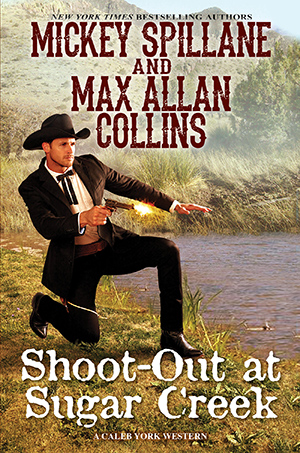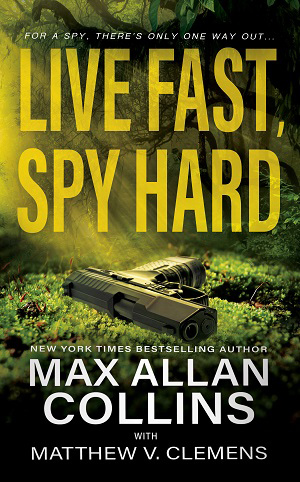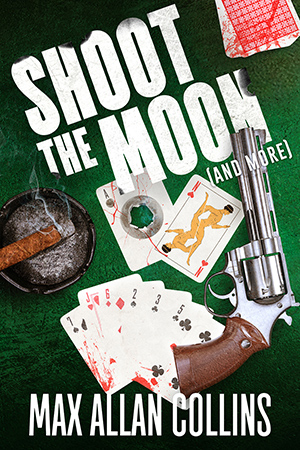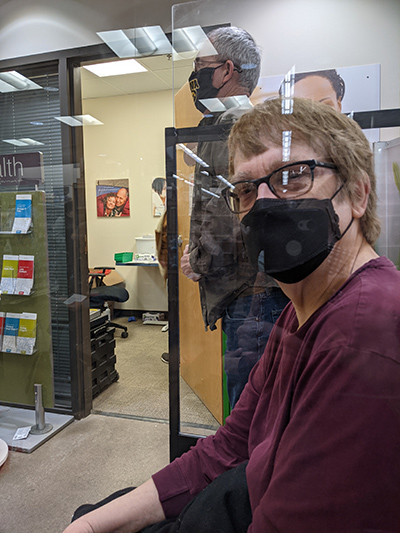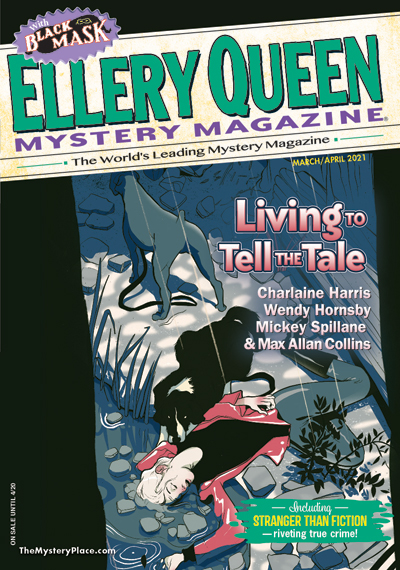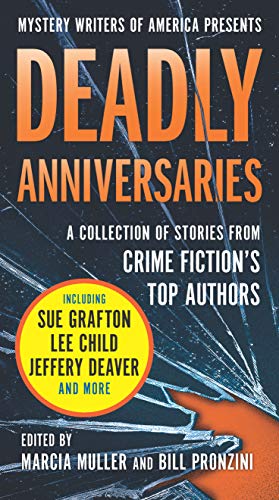Yes, it’s one of our ever-popular book giveaways. I have ten copies to give to the first ten readers who request it and agree to do an Amazon (and/or other) review. Those of you who have won books in the past and have not posted a review yet, for shame. Those of you who have won books and hated the book and haven’t posted a review, thank you.
[All copies for the giveaway have been claimed. Thank you for your support! –Nate]
Anyway, this is for Shoot the Moon, which is a repackaging (with revised intro) of Early Crimes. I’ve done this because Shoot the Moon is a novel and Early Crimes was rather inaccurately described as a collection. What we have is a novel, written about six books into my career, that was my attempt to do a Donald E. Westlake-style comedy of crime. By now you can see that Westlake was a major influence on my work, and was in fact a mentor to me when I was working on Bait Money, the first published Nolan novel, which of course was written as a pastiche/homage to Westlake’s Richard Stark-bylined Parker novels.
So perhaps it was natural that I try to follow in his other footsteps, and Shoot the Moon is that novel. It’s a short novel (but not a novella) and the two early short stories, “Public Servant” and “The Love Rack,” follow the novel as the equivalent of DVD/Blu-ray bonus features.
Back to the book giveaway. Write me at [link removed], and (this is important) include your snail mail address, even if you’ve won before. This is for USA only. That’s not patriotism, it’s cheapness (foreign postage is particularly high in the Covid era).
Speaking of which….
Barb and I have received our first vaccine doses (the Pfizer variety) and we are greatly relieved. How we got it is reflective of the difficulties even those of us who are seniors with underlying conditions are having getting vaccinated for Covid-19. Here’s our story.
For about a month I have been haunting the site of the Hy-Vee supermarket’s pharmacy (Hy-Vee being the major grocery chain in Iowa). It’s where Barb and I step outside of sheltering in place to take in “geezer” hour and do our weekly grocery shopping. The benefits are fewer people and ‘60s-era oldies playing instead of country western.
About four trips to Hy-Vee ago, I stopped at the pharmacy window to ask how I went about getting an appointment for vaccination. I was told by the pleasant young woman to sign up on-line and I would receive updates. (To date, I have received none. I also enrolled at Walgreens and also got zip updates.) On my next trip to the Hy-Vee pharmacy I inquired about when a vaccine shipment might be coming in and learned that one had in fact come in two days ago – 200 doses – and were gone in an hour.
That was when I asked (Barb said, “Don’t be angry!”) why I hadn’t received an update, and was told what I needed to do was keep refreshing the Hy-Vee pharmacy page on Facebook. I went home and began doing that, probably a dozen times a day – not a hardship, as I work at my computer. Two shipments would be coming in the following week, I was assured.
A week later I was told (credibly) the shipments hadn’t made it because of the cold in Texas that Ted Cruz was avoiding. I went home and began refreshing and refreshing.
The next week – this past week – I asked when the next shipment was coming in and was told by the pleasant young woman that it already had and was gone. (Two shipments had become one shipment.) I asked why the updates had never come and why all my refreshing hadn’t indicated any shipment ever had. The answer was not direct. I was advised to go to another web site and sign up there for…updates.
I trudged off and caught up with Barb, who was shopping to the tune of “Swinging School” by Bobby Rydell. I followed, considerably less happy than I usually am hearing Bobby Rydell, who is a favorite. Suddenly I said, “I’m going back there.”
“Why?”
“It’s unclear exactly what page I’m supposed to be refreshing.”
“Be nice.”
This conversation was conducted through masks, of course.
I said, “What do you mean?”
She said, “You’re a hothead.”
Never had I ever been so insulted! That she had a point was…beside the point…or something. I trudged back.
The pleasant young woman behind the counter said, “I was just going to page you.”
“Why?”
“Get your wife. We’ve had two cancellations and we start vaccinating in fifteen minutes.”
I ran – let’s call it power-walked – to Barb, pushing her cart with the patience of Sisyphus pushing his big rock, and at about the same speed.
“Come with me,” I said.
“Why?” She was understandably suspicious.
“They’ve had two cancellations.”
Suddenly my wife loved me again. Suddenly my stubborn hotheadedness had been transformed into blessed persistence.
I don’t blame anybody for this, and I do thank Hy-Vee for stepping up in the war against Covid and for the pleasant young woman having the presence of mind – and, frankly, compassion – to take advantage of those two cancellations…and the opportunity to get rid of me.
The vaccines will start flowing better, I am sure. Some of my readers support Trump, and that’s fine. I like anchovies. But nobody can say Joe Biden isn’t taking this pandemic seriously, and things are going to get better and soon. But right now it felt like the luckiest of lucky breaks to blunder in making a weekly nuisance of myself with stupid questions and a generally incompetent approach to getting vaccinated and be able to fill two cancellations and feel like our lives had been saved.
The bottom line, of course, is: it’s better to be lucky than smart.
* * *
Our sheltering in place has gone on for just about a year, Barb and I. We take it very seriously. Her health is fine, but she’s only a few months younger than me, so she needs protection and I’m not talking condoms. And I have enough underlying conditions to just check “all of the above” on a physician’s questionnaire.
So tomorrow (if you are reading this on the Tuesday it was posted) I will turn 73. It seems unreal to me, but I will tell you this – as long as I have my marbles, and can find venues that will have me, I will keep working. I will keep writing. Skim Deep is the new Nolan novel and the first one appeared in 1973, and was written around 1970. So do the math. It’s almost beyond belief that I recently wrote an entry in a series I created fifty-one years ago.
And I just completed Quarry’s Blood, in a series that began with a book I started in 1971. Fifty years ago.
Mickey Spillane used to talk to me about this – how writing was the only business you could stay at as long as you had decent health, no matter what age you might be. And that you can keep improving all along the way.
I’m not sure if that’s correct. I know there are many things I do better now, but I also know that the rigors of a work like Stolen Away might be beyond me. Nonetheless, I intend to do another Heller later this year, if the contract comes through.
Oh, as for my birthday. I am not fishing for birthday wishes, here or on Facebook or even in my snail-mail mailbox. If you want to send a gift, though, checks are best. Sorry – no PayPal account.
And if you really are, seriously, looking for a way to say Happy Birthday to me, buy one of the recent books: Come Spy With Me, Skim Deep, Masquerade for Murder, Antiques Fire Sale, Reincarnal, Shoot the Moon, Ms. Tree Vol. 2: Skeleton in the Closet, Murderlized, or maybe one of the great audiobooks that Skyboat Media is putting out (they’re doing all of the Nolans!). And the Wolfpack trade paperbacks are very handsome books indeed.
Here’s an idea: post a positive review for Max for his birthday.
* * *
I have seen some interesting things of late. I am particularly taken by a new sub-genre that Groundhog Day has spawned – specifically, movies that openly, unabashedly borrow its premise. Happy Death Day is a crafty horror-movie take on the Time Loop premise, and its sequel, Happy Death Day 2U, is more of the same but also good. Edge of Tomorrow is a strong s-f variation.
Two excellent rom-com takes are streaming right now – Palm Springs starring Cristin Milioti and Andy Samberg, and The Map of Tiny Perfect Things starring Kathryn Newton and Kyle Allen. What’s fascinating about these two is that, despite both depicting a couple caught in a Time Loop with a romance developing, each is different and makes its own point. And, while both films name-check Groundhog Day on screen, they demonstrate that the Time Loop concept has plenty more places to go.
As I say, a new sub-genre.
Now to a controversial topic. Barb and I gave up on Hamilton after about 45 minutes. I’ve made it clear that I am a musical comedy fan – that I love Rodgers and Hammerstein and Stephen Sondheim and Frank Loesser. The upcoming Blu-ray release of Damn Yankees has me giddy. And Hamilton certainly is a spectacle with a stage brimming with energy and talent.
What’s wrong with it – for me – is the rap/hip hop aspect. And that’s my problem. But I can’t get past it. I hate rap almost as much as I hate country western – maybe more. To my ancient ears, it’s just a bunch of rhyming and fast-talk gymnastics, and has little to do with music, although the percussive aspect is catchy in the way melodies used to be.
All-black musicals are nothing new – this one does have a few white faces dropped in – as The Wiz and Ain’t Misbehavin’ and many others demonstrate. All-black revivals of the likes of Guys and Dolls and Hello Dolly! have done very well, both critically and at the box office. But Porgy and Bess and Carmen Jones were originals, and the faithful films of both are both problematic today, I’m afraid, despite the wealth of talent on display.
Hamilton feels like a fad to me, not a Broadway classic unfolding before our eyes. But I am probably wrong.
As I said earlier, I will be 73 this week. This musical isn’t for me. As someone who has loved popular culture my entire life – loved my generation’s pop culture, but also my parents’ and my grandparents’ and much of my son’s – I am disappointed that Hamilton doesn’t touch me the way Sweeney Todd or Carousel or How To Succeed in Business do.
My fault. My loss.
* * *
Here’s a peek at the Spillane/Collins “Mike Hammer” short story, “Killer’s Alley,” in this month’s Ellery Queen Mystery Magazine. Just a taste….
From the great Ron Fortier comes this splendid review of Reincarnal.
Finally, here’s an article on the best Batman stories drawn by Norm Breyfogle, one of which is mine.
M.A.C.
















